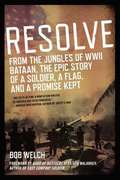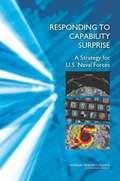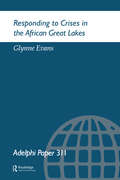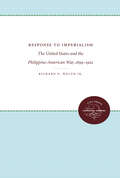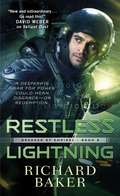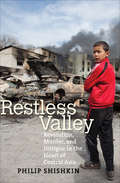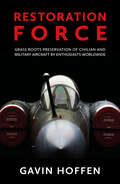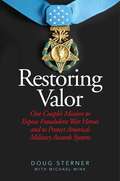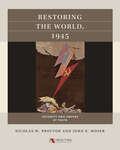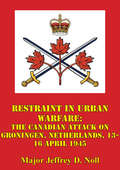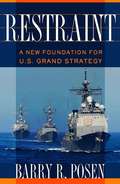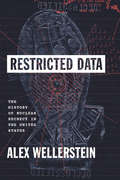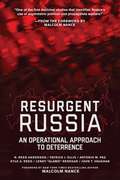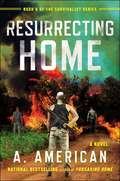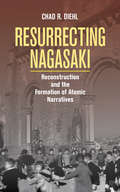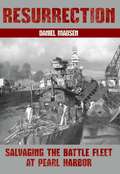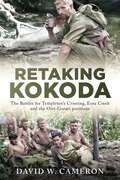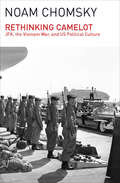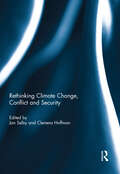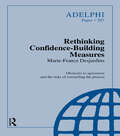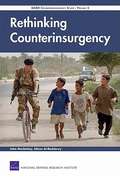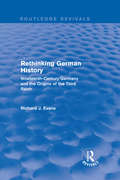- Table View
- List View
Resolve
by Bob WelchOn April 9, 1942, thousands of U.S. soldiers surrendered as the Philippines island of Luzon fell to the Japanese. But a few hundred Americans placed their faith in their own hands and headed for the jungles. One of them was twenty-three-year-old Clay Conner Jr., who had never even camped before . . . The obstacles to Conner's survival were as numerous as the enemy soldiers who ultimately put a price on his head: among them malaria, heat, jungle rot, snakes, and mosquitoes. Beyond that, the human threats of betrayal, capture, torture, and death. And, finally, he had to overcome self-doubt, struggle with the despair of burying comrades, deal with friction among his fellow American soldiers, and find a way to survive. But if conflict reveals character, Conner showed himself to be a man apart. Inspired by an unlikely alliance with a tribe of arrow-shooting pygmies, by the words in a dog-eared New Testament, and by a tattered American flag that he vowed to someday triumphantly fly at battalion headquarters, Conner emerged victorious from the jungle--after almost three years. Resolve is the story of an unlikely hero who never surrendered to the enemy--and of a soldier who never gave up hope.
Responding to Capability Surprise
by National Research Council Naval Studies Board Division on Engineering and Physical Sciences Committee on Capability Surprise on U.S. Naval ForcesFrom a military operational standpoint, surprise is an event or capability that could affect the outcome of a mission or campaign for which preparations are not in place. By definition, it is not possible to truly anticipate surprise. It is only possible to prevent it (in the sense of minimizing the number of possible surprises by appropriate planning), to create systems that are resilient to an adversary's unexpected actions, or to rapidly and effectively respond when surprised. Responding to Capability Surprise examines the issues surrounding capability surprise, both operational and technical, facing the U.S. Navy, Marine Corps, and Coast Guard. This report selects a few surprises from across a continuum of surprises, from disruptive technologies, to intelligence-inferred capability developments, to operational deployments, and assesses what the Naval Forces are doing (and could do) about them while being mindful of future budgetary declines. The report then examines which processes are in place or could be in place in the Navy, the Marine Corps, and the Coast Guard to address such surprises. Today's U.S. naval forces continue to face a wide range of potential threats in the indefinite future and for this reason must continue to balance and meet their force structure needs. The recommendations of Responding to Capability Surprise will help to ensure more responsive, more resilient, and more adaptive behavior across the organization from the most senior leadership to the individual sailors, Marines, and Coast Guardsmen.
Responding to Crises in the African Great Lakes (Adelphi series)
by G. EvansExamines the international responses to the ethnic conflicts in Burundi and Rwanda from 1993-1997 and their overspill into Zaire. Concludes that the external reaction was impotent and incoherent, and urges a number of changes in response by the international community.
Response to Imperialism: The United States and the Philippine-American War, 1899-1902
by Richard E. WelchThis is a study of the impact of the Filipino Insurrection on American society and politics. It is the first work to evaluate in detail the response of public opinion to that war and to analyze official and popular response in the light of the values and anxieties of the American people. Although that response suggests parallels with American intervention in Vietnam, it must be evaluated within the context of the diplomatic ambitions of the United States during 1899-1902.Originally published 1979.A UNC Press Enduring Edition -- UNC Press Enduring Editions use the latest in digital technology to make available again books from our distinguished backlist that were previously out of print. These editions are published unaltered from the original, and are presented in affordable paperback formats, bringing readers both historical and cultural value.
Restless Lightning: Breaker of Empires, Book 2 (Breaker of Empires #2)
by Richard BakerRichard Baker continues the adventures of Sikander North in Restless Lightning, the second book in his new military science fiction series Breaker of Empires and sequel to Valiant Dust.Lieutenant Sikander North has avoided an outright court martial and finds himself assigned to a remote outpost in the crumbling, alien Tzoru Empire—where the navy sends trouble-makers to be forgotten. When Sikander finds himself in the middle of an alien uprising, he, once again, must do the impossible: smuggle an alien ambassador off-world, break a siege, and fight the irrational prejudice of his superior officers. The odds are against his success, and his choices could mean disgrace—or redemption.Breaker of Empires#1 Valiant Dust#2 Restless LightningAt the Publisher's request, this title is being sold without Digital Rights Management Software (DRM) applied.
Restless Valley: Revolution, Murder, and Intrigue in the Heart of Central Asia
by Philip ShishkinThis award-winning foreign correspondent&’s vivid account of Central Asia&’s recent history &“reads like a novel but is the stuff of hard-won journalism&” (Gary Shteyngart, author of Absurdistan). Here are the stories of two revolutions, a massacre of unarmed civilians, a civil war, a drug-smuggling highway, brazen corruption schemes, contract hits, and larger-than-life characters who may be villains, heroes, or possibly both. Restless Valley is a gripping, contemporary chronicle of Central Asia from a veteran journalist with extensive experience in the region. Both Kyrgyzstan and Uzbekistan have struggled with the challenges of post-Soviet, independent statehood, and both became entangled in America&’s Afghan campaign when the United States built military bases within their borders. Meanwhile, the region was becoming a key smuggling hub for Afghanistan&’s booming heroin trade. Through the eyes of local participants—the powerful and the powerless—Shishkin reconstructs how Kyrgyzstan and Uzbekistan have ricocheted between extreme repression and democratic strivings; how alliances with the United States and Russia have brought mixed blessings; and how Stalin&’s legacy of ethnic gerrymandering continues to incite conflict today. &“The weird, the strange, the corrupt, and the grand are all evident . . . [Shishkin] relentlessly pursues and then tells the stories of the most corrupt and powerful and also the most sincere and admirable characters who inhabit these mountains.&” —Ahmed Rashid, The New York Review of Books
Restless: A Novel
by William BoydRestless, as the name implies, is a fast moving (geographically and socially) novel, post WWII England. The war has an impact because the main character is transplanted from Russia to London to spy on her homeland, while equally observant of a few vulnerable Brits. EVA, turned Sally, maintains her cover even to her daughter. Her true identity is revealed further precipitated by affairs of the heart. Restless is replete with intense personal dynamics and their fall-out.
Restoration Force: Grass Roots Preservation of Civilian and Military Aircraft by Enthusiasts Worldwide
by Gavin HoffenWe can all walk into any of the myriad aircraft museums dotted across the world and appreciate the wonderfully restored and preserved exhibits on display. But what about the many gems lovingly brought back to life and hiding away in people’s garages, sheds, barns and gardens? With Gavin Hoffen’s book you become a privileged spectator into a dedicated but often secretive world – to protect their security, names, projects and locations have been limited to the very basics. This is the nostalgic domain of the amateur restorer, hobbyist, and ‘cockpiteer’ of which Gavin is one. Here you will find complete coverage of over 20 projects worldwide with background histories of the aircraft, color photos of the restoration and full information and specifications – be it of cockpit, fuselage, or full aircraft. From Spitfire to Chipmunk, Vulcan to Buccaneer, Piper Aztec to B-52, this is a fascinating insight into an obsession with the romance that aviation once was. A must-see for every aircraft aficionado, and an inspiration for future preservers.
Restoring Valor: One Couple’s Mission to Expose Fraudulent War Heroes and to Protect America’s Military Awards System
by Pam Sterner Doug SternerStolen valor occurs when a person lies about receiving military decorations that he or she has in fact never earned. It has become a major societal problem that has been discussed numerous times in the news and, most recently, by the US Supreme Court. According to The New York Times, the Department of Veterans Affairs paid disability benefits to more than six hundred people falsely claiming to have been POWs in the Vietnam and Persian Gulf wars. The number of stolen valor cases reported to the FBI has tripled in the last decade. In fact, more imposters lie about earning high military declarations for battlefield bravery than the actual number of real-life hero recipients. These imposters trade on tales and the trappings of military valor to secure privileges such as career advancements and even unearned veterans' benefits.Because officially recognized valor is a calling card of trust and courage, many of these imposters "steal" it to invade the lives of people and institutions, for personal gain and often with criminal results. In Restoring Valor, Doug Sterner provides riveting case studies of the stolen valor imposters he's investigated and exposed, and the serious crimes -- including murder -- they've committed. He chronicles the evolution of stolen valor from the inception of the republic to today. Sterner demonstrates why the federal law he and his wife Pam helped to enact, called the Stolen Valor Act, is necessary.
Restoring the World, 1945: Security and Empire at Yalta (Reacting to the Past™)
by Nicolas W. Proctor John E. MoserThe devastation of the Second World War is coming to an end. As victory for the Grand Alliance draws close, the leaders of Great Britain, the Soviet Union, and the United States gather at Yalta, a resort town on the Black Sea, for the most important summit meeting of the war. Can the great powers finalize their plans for a new world order, or will their often antagonistic ideologies prevent them from forging a lasting peace? Restoring the World immerses students in the Yalta Conference as they take on the roles of Churchill, Roosevelt, Stalin, as well as the members of their military and diplomatic delegations. They all want peace, but what kind of peace will they create?
Restraint In Urban Warfare: The Canadian Attack On Groningen, Netherlands, 13-16 April 1945
by Major Jeffrey D. Noll U.S. ArmyUrban terrain presents significant tactical challenges to attacking armies, limiting weapons effects and mobility while disrupting formations and command and control. The human terrain in cities creates a tactical dilemma, placing large civilian populations in close proximity to the fighting. The issue of restraint in urban warfare has been described as a modern phenomenon, with urban warfare in World War II characterized as unlimited. In April 1945, however, the Canadian Army limited its firepower while attacking the city of Groningen, Netherlands to limit damage and civilian casualties. This thesis examines the reasons for these restraints and the methods used to balance those restraints with accomplishment of the mission. The Canadians limited their use of force for political reasons based on intent from the British. They accomplished their mission due to intelligence gained from the friendly population, local fire superiority gained by tanks and flamethrowers, and the ineffectiveness of the poorly organized and equipped German defense. This thesis provides a historical case study of the reasons for restraint in urban warfare and the tactical challenges associated with such limitations.
Restraint: A New Foundation for U.S. Grand Strategy
by Barry R. PosenThe United States, Barry R. Posen argues in Restraint, has grown incapable of moderating its ambitions in international politics. Since the collapse of Soviet power, it has pursued a grand strategy that he calls "liberal hegemony," one that Posen sees as unnecessary, counterproductive, costly, and wasteful. Written for policymakers and observers alike, Restraint explains precisely why this grand strategy works poorly and then provides a carefully designed alternative grand strategy and an associated military strategy and force structure. In contrast to the failures and unexpected problems that have stemmed from America's consistent overreaching, Posen makes an urgent argument for restraint in the future use of U. S. military strength. After setting out the political implications of restraint as a guiding principle, Posen sketches the appropriate military forces and posture that would support such a strategy. He works with a deliberately constrained notion of grand strategy and, even more important, of national security (which he defines as including sovereignty, territorial integrity, power position, and safety). His alternative for military strategy, which Posen calls command of the commons, focuses on protecting U. S. global access through naval, air, and space power, while freeing the United States from most of the relationships that require the permanent stationing of U. S. forces overseas. "
Restraint: A New Foundation for U.S. Grand Strategy
by Barry R. PosenThe United States, Barry R. Posen argues in Restraint, has grown incapable of moderating its ambitions in international politics. Since the collapse of Soviet power, it has pursued a grand strategy that he calls "liberal hegemony," one that Posen sees as unnecessary, counterproductive, costly, and wasteful. Written for policymakers and observers alike, Restraint explains precisely why this grand strategy works poorly and then provides a carefully designed alternative grand strategy and an associated military strategy and force structure. In contrast to the failures and unexpected problems that have stemmed from America's consistent overreaching, Posen makes an urgent argument for restraint in the future use of U.S. military strength.After setting out the political implications of restraint as a guiding principle, Posen sketches the appropriate military forces and posture that would support such a strategy. He works with a deliberately constrained notion of grand strategy and, even more important, of national security (which he defines as including sovereignty, territorial integrity, power position, and safety). His alternative for military strategy, which Posen calls "command of the commons," focuses on protecting U.S. global access through naval, air, and space power, while freeing the United States from most of the relationships that require the permanent stationing of U.S. forces overseas.
Restricted Data: The History of Nuclear Secrecy in the United States
by Alex Wellerstein“Groundbreaking . . . Wellerstein peels back the layers of the nuclear onion to reveal a rich debate about what should be kept secret and why.” —NatureThe first full history of US nuclear secrecy, from its origins in the late 1930s to our post–Cold War present.The American atomic bomb was born in secrecy. From the moment scientists first conceived of its possibility to the bombings of Hiroshima and Nagasaki and beyond, there were efforts to control the spread of nuclear information and the newly discovered scientific facts that made such powerful weapons possible. The totalizing scientific secrecy that the atomic bomb appeared to demand was new, unusual, and very nearly unprecedented. It was foreign to American science and American democracy—and potentially incompatible with both. From the beginning, this secrecy was controversial, and it was always contested. The atomic bomb was not merely the application of science to war, but the result of decades of investment in scientific education, infrastructure, and global collaboration. If secrecy became the norm, how would science survive? Drawing on troves of declassified files, including records released by the government for the first time through the author’s efforts, Restricted Data traces the complex evolution of the US nuclear secrecy regime from the first whisper of the atomic bomb through the mounting tensions of the Cold War and into the early twenty-first century. A compelling history of powerful ideas at war, it tells a story that feels distinctly American: rich, sprawling, and built on the conflict between high-minded idealism and ugly, fearful power. “Wellerstein examines the health of democracy in the face of big science, big government, and big weapons.” ―Science
Resurgent Russia: An Operational Approach to Deterrence
by Malcolm Nance R. Reed Anderson Patrick J. Ellis Antonio M. Paz Kyle A. Reed Lendy Alamo" Renegar John T. VaughanRelations between the United States and Russia have recently escalated from strained to outright aggressive. From imperial expansion in Ukraine to intervention in Syria to Russian hacking during the US election in 2016, it is clear that the United States must be prepared to defend itself and its NATO allies against Russian aggression.Resurgent Russia, researched and written by six residents and internationally experienced officers at the US Army War College, analyzes the current threat of Russian acts of war—both conventional military attacks and unconventional cyber warfare or political attacks—against the United Stated and NATO. The officers detail how the America can use its international military resources and political influence to both prepare for and deter aggression ordered by Vladimir Putin, making it clear that such an attack would be unsuccessful and therefore keeping the peace. This study provides a clear assessment of how the United States and its allies must utilize their political and military power to deter Russian aggression and maintain the hierarchy of power in today’s world.
Resurrecting Home
by A. AmericanBOOK 5 OF THE SURVIVALIST SERIES Against all odds, Morgan Carter and his family have endured despite the deteriorating conditions surrounding them. Armed with survivalist tactics, Morgan's crew, alongside their new friends from the recently-liberated DHS camp, have worked together to build a sustainable communuity. But not all situations can be prepared for. When a massive wildfire threatens their very existence, they must decide: fight or flight? From the author of the hit Survivalist Series books, Resurrecting Home is an action-packed adventure that depicts the harrowing possibilities of a world gone awry, and the courage it takes to protect what matters most.
Resurrecting Nagasaki: Reconstruction and the Formation of Atomic Narratives (Studies of the Weatherhead East Asian Institute, Columbia University)
by Chad R. DiehlIn Resurrecting Nagasaki, Chad R. Diehl explores the genesis of narratives surrounding the atomic bombing of August 9, 1945, by following the individuals and groups who contributed to the shaping of Nagasaki City's postwar identity. Municipal officials, survivor-activist groups, the Catholic community, and American occupation officials all interpreted the destruction and reconstruction of the city from different, sometimes disparate perspectives. Diehl's analysis reveals how these atomic narratives shaped both the way Nagasaki rebuilt and the ways in which popular discourse on the atomic bombings framed the city's experience for decades.
Resurrection
by Daniel MadsenThe attack on Pearl Harbor is a topic of perennial interest to the American public, and a long line of popular books and movies have focused on the attack or events leading up to it. This work takes an entirely new perspective. Aimed at the general reader with an interest in World War II and the U.S. Navy, the book looks at the massive salvage effort that followed the attack, beginning with the damage control efforts aboard the sinking and damaged ships in the harbour on 7 December 1941 and ending in March 1944 when salvage efforts on the USS Utah were finally abandoned. The author tells the story in a narrative style, moving from activity to activity as the days and months wore on, in what proved to be an incredibly difficult and complex endeavour. But rather than writing a dry operational report, Dan Madsen describes the Navy's dramatic race to clear the harbour and repair as many ships as possible so they could return to the fleet ready for war. Numerous photographs, many never before published in books for the general public, give readers a real appreciation for the momentous task involved, from the raising of the USS Oglala in 1942 and the USS Oklahoma in 1943 to the eventual dismantling of the above-water portions of the USS Arizona. Madsen explains how a salvage organization was first set up, how priorities were scheduled, what specific plans were made and how they worked or, in many cases, did not work. His book is based almost entirely on primary sources, including the records of the fleet salvage unit and the Pearl Harbor Naval Shipyard.
Retail Marketing
by J. BlythmanFirst published in 2004, Retail Marketing is a valuable contribution to the field of Military & Strategic Studies.
Retaking Kokoda: The Battles for Templeton's Crossing, Eora Creek and the Oivi-Gorari positions
by David W. CameronJapanese Major General Horii Tomitarô, commanding the South Seas Force, had the Australians on the back foot. Australia was holding the last defendable ridge in the Owen Stanley ranges, Imita Ridge. Horii to his distress was then given orders from Imperial Headquarters in Tokyo that he was to fall back across the mountains to the Japanese beachheads at Gona, Sanananda, and Buna, leaving a force between Templeton’s Crossing and Eora Creek to stop any Australian advance through the mountains. The Japanese, unknown to the Australians evacuated Ioribaiwa Ridge just before they launched their attacks and to their amazement on storming the heights, the Australians encountered no resistance – the Japanese had gone. <p><p> This, however, did not mean the fighting on the Kokoda Track was over, far from it. Three more desperate actions would be fought by the Australians and Japanese, before the decisive battles for the Japanese beachheads could be decided – the battles for Templeton’s Crossing, Eora Creek, and finally the Oivi-Gorari positions on the northern lowland plains. Just 15-kilometres east lay the Kumusi River, the last geographical barrier before reaching the strongly fortified Japanese beachheads themselves.
Rethinking Camelot: JFK, the Vietnam War, and U.S. Political Culture
by Noam ChomskyThe famed political critic &“analyzes the issue most prominently posed in Oliver Stone&’s film JFK . . . strong arguments against Kennedy mythologists&” (Publishers Weekly). Rethinking Camelot is a thorough analysis of John F. Kennedy&’s role in the US invasion of Vietnam and a probing reflection on the elite political culture that allowed and encouraged the Cold War. In it, Chomsky dismisses efforts to resurrect Camelot—an attractive American myth portraying JFK as a shining knight promising peace, foiled only by assassins bent on stopping this lone hero who would have unilaterally withdrawn from Vietnam had he lived. Chomsky argues that US institutions and political culture, not individual presidents, are the key to understanding US behavior during Vietnam. Rethinking Camelot is &“an interesting work not only for the history it explores, but also as a study of how various individuals and groups write and interpret history&” (Choice). Praise for Noam Chomsky &“Chomsky is a global phenomenon . . . perhaps the most widely read voice on foreign policy on the planet.&” —The New York Times Book Review &“The conscience of the American people.&” —New Statesman &“Reading Chomsky is like standing in a wind tunnel. With relentless logic, Chomsky bids us to listen closely to what our leaders tell us—and to discern what they are leaving out . . . The questions Chomsky raises will eventually have to be answered. Agree with him or not, we lose out by not listening.&” —Business Week &“One of the radical heroes of our age . . . a towering intellect . . . powerful, always provocative.&” —The Guardian
Rethinking Climate Change, Conflict and Security
by Jan Selby and Clemens HoffmannIs global climate change likely to become a significant source of violent conflict, and should it therefore be seen as a national security challenge? Most Northern governments, militaries, think tanks and NGOs believe so, as do many academic researchers, on the grounds that increased temperatures, changing precipitation patterns and rising sea levels will worsen existing social stresses, especially within poor societies and marginal communities across Africa and Asia. This book argues otherwise. The first collection of its kind, it brings together leading scholars of Anthropology, Geography, Development Studies and International Relations to provide a series of critical analyses of mainstream thinking on the climate-security nexus. It shows how policy discourse on climate conflict consistently misrepresents the causes of violence, especially by obscuring its core political dimensions. It demonstrates that quantitative research provides a flawed basis for understanding climate-conflict linkages. It argues that climate security discourse is in hoc with a range of questionable military, authoritarian and developmental agendas. And it reveals that the greening of global capitalism is already having violent consequences across the global South. Climate change, the book argues, does indeed have serious conflict and security implications – but these are quite different from how they are usually imagined.This book was published as a special issue of Geopolitics.
Rethinking Confidence-Building Measures (Adelphi series)
by Marie-France DesjardinsConfidence-Building Measures (CBMs) - often seen as the fastest growing sector on the post-Cold War diplomatic agenda - are increasingly viewed by the international community as useful instruments for addressing a range of security and diplomatic issues. Rethinking Confidence-Building Measures warns against an uncritical pursuit of CBMs, arguing that the idea has been oversold. The author asserts that obstacles to meaningful agreements are much more important than usually acknowledged, and the political and military ramifications have been generally ignored. She concludes that the same effort, painstaking negotiation, and possibilities for failure are inherent in CBMs as in the wide array of other potential solutions for managing interstate security relations, but with far fewer substantial results.
Rethinking Counterinsurgency
by Alison Al-Baddawy John MackinlayDuring the period of decolonization in Asia and Africa, the United Kingdom faced more insurgent activity than any other Western power. British government officials and military forces proved proficient at defeating or controlling these rebellions. However, these uprisings were much less complex than the modern jihadist insurgency. Past insurgent movements were primarily monolithic or national in form, had very specific local goals, and derived most of their power from the local population. These limitations made past rebellions vulnerable to strong military responses. In contrast, the modern jihadist insurgency is characterized by its complex and global nature. Unlike past insurgent forms that aspired to shape national politics, the jihadist movement espouses larger thematic goals, like overthrowing the global order. The modern jihadist insurgency is also more global in terms of its popular support and operational territory. It makes far better use of communications technology and propaganda to reach the minds and hearts of global audiences. The contemporary international security environment has therefore become a frustrating place for Western powers. Despite great technological and military advances, British and U.S. counterinsurgency (COIN) operations have been slow to respond and adapt to the rise of the global jihadist insurgency. Operational failures in Iraq and Afghanistan have highlighted the need for the West to rethink and retool its current COIN strategy. After analyzing past British COIN experiences and comparing them to the evolving nature of the modern jihadist insurgency, the authors suggest a new framework for future COIN operations.
Rethinking German History: Nineteenth-Century Germany and the Origins of the Third Reich (Routledge Revivals)
by Richard J. EvansIn Rethinking German History, first published in 1987, Richard J. Evans argues for a social-historical approach to the German past that pays equal attention to objective social structures and subjective values and experiences. If German history has been seen as an exception to the ‘normal’ development of Western society, this is not least because historians have until recently largely failed to look beyond the world of high politics, institutions, organizations and ideologies to broader historical problems of German society and German mentalities. By applying and adapting approaches learned from French and British social history as they have been developed over the last quarter of a century, it is possible to achieve a rethinking of German history which does away with many of the textbook myths that have encrusted the historiogrpahy of Germany for so long. This book will be valuable for students of German history and politics, and brings together essays widely used in teaching. Its broad coverage of social history will also be useful to all those interested in contemporary historiography or the comparative study of European history.
